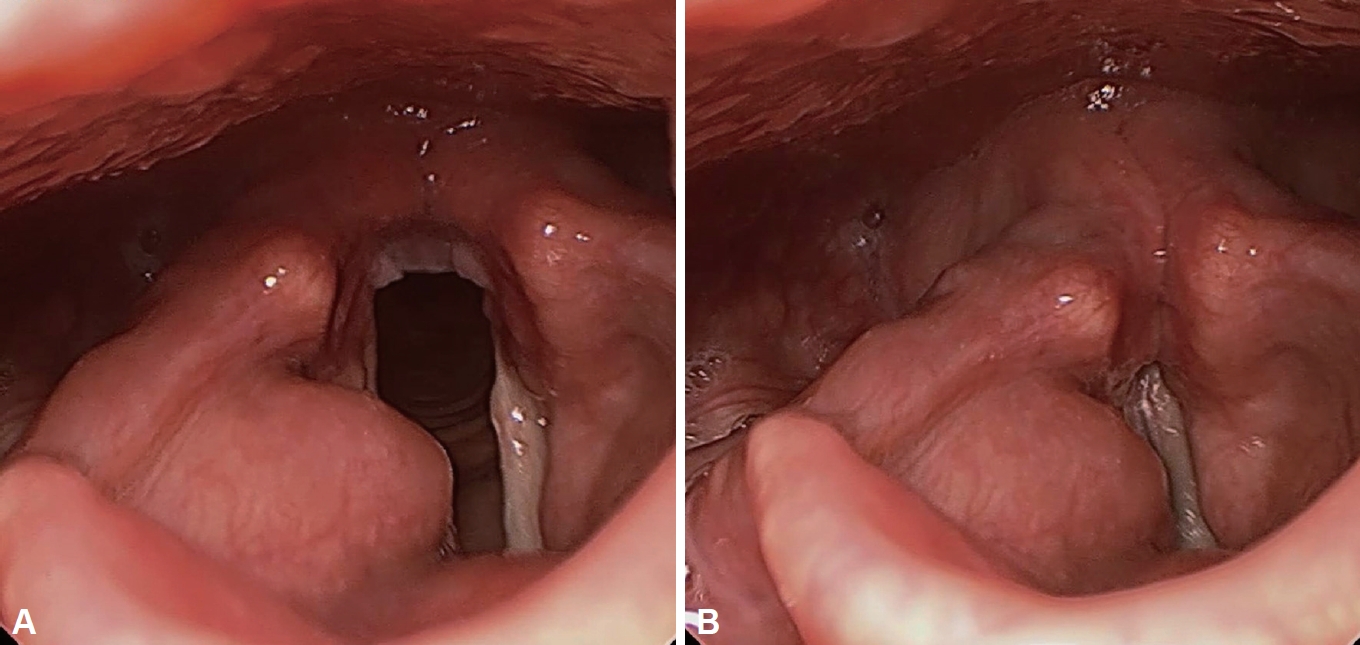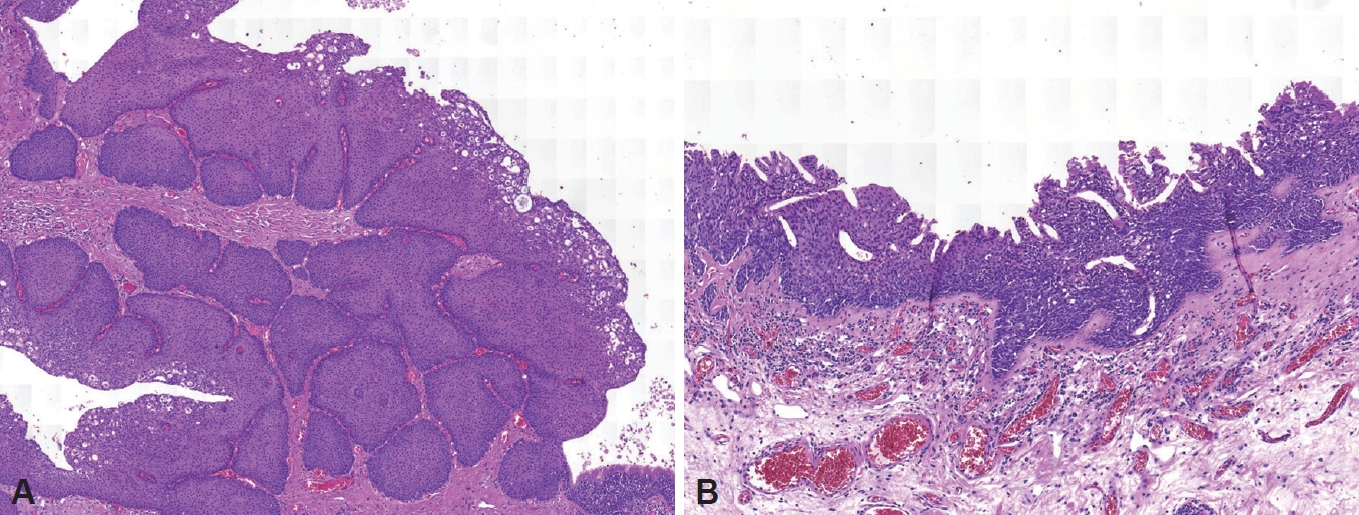AbstractInverted papilloma is a rare benign tumor which usually arises from sinonasal mucosa. We experienced a case of 62-year-old male who presented with foreign body sensation in throat. A round mass was found at right false vocal cord in laryngoscopic examination. It was excised in laryngeal microsurgery. The pathologic diagnosis was inverted papilloma of false vocal cord. Recurrence or complication did not occur during the follow up period of three months.
ņä£ ļĪĀļ░śņĀäņä▒ ņ£ĀļæÉņóģņØĆ ļō£ļ¼╝Ļ▓ī ļéśĒāĆļéśļŖö ļ╣äĻ░ĢņØś ņ¢æņä▒ ņóģņ¢æņ£╝ļĪ£ ņĀäņ▓┤ ļ╣äĻ░Ģ ņóģņ¢æņØś 0.5~4%ļź╝ ņ░©ņ¦ĆĒĢ£ļŗż. ņŻ╝ļĪ£ ļ╣äĻ░ĢņØś ņĖĪļ▓ĮņØ┤ļéś ļČĆļ╣äļÅÖņŚÉņä£ ņ”ØņŗØļÉ£ ņāüĒö╝ņäĖĒżĻ░Ć ļ░śņĀäņä▒ņ£╝ļĪ£ ĻĖ░ņ¦ł ļé┤ļĪ£ ņä▒ņןĒĢśņŚ¼ ļ░£ņāØĒĢ£ļŗż[1]. ņØ┤ļ¤¼ĒĢ£ ļ░śņĀäņä▒ ņ£ĀļæÉņóģņØĆ ņŻ╝ļĪ£ 40~70ņäĖņŚÉ ļ░£ņāØĒĢśļ®░ ņåīņĢäļéś ņ▓ŁņåīļģäĻĖ░ņŚÉļŖö ļō£ļ¼Ė Ļ▓āņ£╝ļĪ£ ņĢīļĀżņĀĖ ņ׳ņ£╝ļ®░, ļé©ļģĆ ļ╣äļŖö 4:1ļĪ£ ļ│┤Ļ│ĀļÉ£ļŗż[2]. ļ│æļ”¼ĒĢÖņĀüņ£╝ļĪ£ ņ¢æņä▒ ņóģņ¢æņØ┤ņ¦Ćļ¦ī ņ×¼ļ░£ļźĀņØ┤ ļåÆĻ│Ā Ļ│© ļ░Å ņŻ╝ņ£ä ņĪ░ņ¦üņØä ĒīīĻ┤┤ĒĢĀ ņłś ņ׳ņ£╝ļ®░, ņĢģņä▒ ņóģņ¢æĻ│╝ņØś ņŚ░Ļ┤Ćņä▒ņØ┤ ņĄ£ļīĆ 15%Ļ╣īņ¦Ć ņ׳ļŖö Ļ▓āņ£╝ļĪ£ ņĢīļĀżņĀĖ ņ׳ņ¢┤ ņ×äņāüņĀüņ£╝ļĪ£ļŖö ņĢģņä▒ ņóģņ¢æĻ│╝ Ļ░ÖņØ┤ ņĘ©ĻĖēļÉśĻ│Ā ņ׳ņ£╝ļ®░ Ļ┤æļ▓öņ£äĒĢ£ ņłśņłĀņĀü ņĀ£Ļ▒░ ļ░Å ņ¦ĆņåŹņĀüņØĖ ņČöņĀüņØ┤ ĒĢäņÜöĒĢśļŗż[3].
ļ╣äĻ░Ģ ņØ┤ņÖĖņŚÉņä£ņØś ļ░£ņāØņØĆ ļō£ļ¼Ė Ļ▓āņ£╝ļĪ£ ņĢīļĀżņĀĖ ņ׳ņ£╝ļéś ņØ╝ļČĆ ļ¼ĖĒŚīņŚÉņä£ ļ╣äĻ░Ģ ņÖĖ ļ░£ņāØņØ┤ ļ│┤Ļ│ĀļÉ£ ļ░ö ņ׳ļŗż. SwaidņÖĆ Alsaied [4]ļŖö ņä▒ļ¼ĖņāüņŚÉņä£ ļ░£ņāØĒĢ£ ļ░śņĀäņä▒ ņ£ĀļæÉņóģ 1ņśłļź╝ ņĄ£ņ┤łļĪ£ ļ│┤Ļ│ĀĒĢ£ ļ░ö ņ׳ņ£╝ļéś, ņØ┤Ēøä ļ│┤Ļ│ĀļÉ£ ļ░ö ņŚåļŗż. ņØ┤ņŚÉ ļ│Ė ņ”ØļĪĆļ│┤Ļ│ĀņŚÉņä£ļŖö ĻĄŁļé┤ņŚÉņä£ ņĄ£ņ┤łļĪ£ ĒÖĢņØĖļÉ£ ņä▒ļ¼ĖņāüņØś ļ░śņĀäņä▒ ņ£ĀļæÉņóģ 1ņśłļź╝ ļ│┤Ļ│ĀĒĢśĻ│Āņ×É ĒĢ£ļŗż.
ņ”Ø ļĪĆ62ņäĖ ļé©ņ×É ĒÖśņ×ÉĻ░Ć ļé┤ņøÉ 2Ļ░£ņøö ņĀäļČĆĒä░ ļ░£ņāØĒĢ£ Ļ▓ĮļČĆ ņØ┤ļ¼╝Ļ░ÉņØä ņŻ╝ņåīļĪ£ ļ│ĖņøÉ ņÖĖļלņŚÉ ļé┤ņøÉĒĢśņśĆļŗż. ņÖĖļלņŚÉņä£ ņŗ£Ē¢ēĒĢ£ ĒøäļæÉļé┤ņŗ£Ļ▓ĮĻ▓Ćņé¼ņāü ņÜ░ņĖĪ Ļ░Ćņä▒ļīĆņŚÉ ņ¦üĻ▓Į 2 cmĻ░Ćļ¤ēņØś ņóģļ¼╝ņØ┤ ĒÖĢņØĖļÉśņŚłļŗż(Fig. 1). Ļ▓ĮļČĆ ņĀäņé░ĒÖöļŗ©ņĖĄņ┤¼ņśüņāü Ļ▓ĮĻ│ä ļČĆņ£äņŚÉ ņĪ░ņśüņØ┤ ņ”ØĻ░ĢļÉśĻ│Ā ļé┤ļČĆņŚÉ Ļ▓®ļ▓ĮņØ┤ ļÅÖļ░śļÉ£ ņåīņŚĮņāüņØś(lobulated) ļéŁņä▒ ļ│æļ│ĆņØ┤ Ļ┤Ćņ░░ļÉśņŚłļŗż(Fig. 2). ņØ┤Ēøä, Ļ▓ĮļČĆ ņ×ÉĻĖ░Ļ│Ąļ¬ģņśüņāüņØä ņ┤¼ņśüĒĢśņśĆĻ│Ā T2 Ļ░ĢņĪ░ņśüņāüņŚÉņä£ ņżæļō▒ļÅäņØś ņŗĀĒśĖļź╝ ļ│┤ņśĆļŗż(Fig. 3). ņ×äņāü ļ░Å ņśüņāüĻ▓Ćņé¼ņāü ĒøäļæÉļéŁņóģ(laryngocele) Ļ░ĆļŖźņä▒ņØ┤ ļåÆļŗżĻ│Ā ĒÖĢņØĖļÉśņ¢┤, ņĪ░ņ¦üĻ▓Ćņé¼ ļ░Å ņ╣śļŻī ļ¬®ņĀüņ£╝ļĪ£ ĒøäļæÉļ»ĖņäĖĒśäļ»ĖĻ▓ĮĒĢś ļĀłņØ┤ņĀĆ ņĀłņĀ£ņłĀņØä ņĀäņŗĀļ¦łņĘ©ĒĢśņŚÉ ņŗ£Ē¢ēĒĢśņśĆļŗż. ņ¢æņä▒ ņóģņ¢æņØś ņłśņłĀņŚÉ ņżĆĒĢśņŚ¼ ņóģņ¢æņØś Ļ▓ĮĻ│äļź╝ ļö░ļØ╝ ņĀłņĀ£ĒĢśņśĆņ£╝ļ®░, ņłśņłĀ ņżæ ļÅÖĻ▓░ņĀłĒÄĖĻ▓Ćņé¼ļŖö ņŗ£Ē¢ēĒĢśņ¦Ć ņĢŖņĢśļŗż. ņóģļ¼╝ ņĀłņĀ£ ņØ┤Ēøä, ņĀłņĀ£ņŚ░ņØ┤ ņØ╝ļČĆļČä ļŗ©ļŗ©ĒĢśĻ▓ī ļ¦īņĀĖņ¦ĆļŖö Ļ▓āņØä ĒÖĢņØĖĒĢśņśĆņ£╝ļ®░, ņłśņłĀ Ēøä ņĄ£ņóģ ļ│æļ”¼Ļ▓Ćņé¼ Ļ▓░Ļ│╝ņŚÉ ļö░ļØ╝ ĒĢäņÜö ņŗ£ ņČöĻ░ĆņĀüņØĖ ņ╣śļŻī Ļ│äĒÜŹņØä ņłśļ”ĮĒĢśĻĖ░ļĪ£ ĒĢśņśĆļŗż.
ņłśņłĀ Ēøä hematoxylin and eosin ņŚ╝ņāēņØä ĒåĄĒĢ£ ļ│æļ”¼Ļ▓Ćņé¼ Ļ▓░Ļ│╝, Ļ│╝ĒśĢņä▒ļÉ£ ĒÄĖĒÅēņāüĒö╝ņäĖĒżĻ░Ć ĻĖ░ņ¦ł ļé┤ļĪ£ ļé┤ļ▓łĒĢśļŖö ņ¢æņāüņØ┤ ĒÖĢņØĖļÉśņ¢┤ ļ░śņĀäņä▒ ņ£ĀļæÉņóģņ£╝ļĪ£ ņ¦äļŗ©ļÉśņŚłļŗż(Fig. 4). Ēśäņ×¼ ņłśņłĀ Ēøä ņĢĮ 3Ļ░£ņøö Ļ▓ĮĻ│╝ĒĢ£ ņāüĒā£ļĪ£ Ļ▓ĮļČĆ ņĀäņé░ĒÖöļŗ©ņĖĄņ┤¼ņśü ļ░Å ĒøäļæÉļé┤ņŗ£Ļ▓Į Ļ▓Ćņé¼ņāü ņ×¼ļ░£ ļ░Å ĒĢ®ļ│æņ”Ø ņŚåņØ┤ ņל ņ╣śņ£ĀļÉ£ ņåīĻ▓¼ņØä ļ│┤ņśĆļŗż(Fig. 5).
Ļ│Ā ņ░░ļ░śņĀäņä▒ ņ£ĀļæÉņóģņØĆ ņÖĖļ░░ņŚĮ ĻĖ░ņøÉņØś ņä¼ļ¬©ĒśĖĒØĪņāüĒö╝ņØĖ schneiderian ņāüĒö╝ņŚÉņä£ ļ░£ņāØĒĢśļ®░ ņŻ╝ļĪ£ ļ╣äļČĆļ╣äĻ░Ģ ļé┤ņŚÉ ļ░£ņāØĒĢ£ļŗż[5]. Schneiderian ņāüĒö╝ņŚÉņä£ ļ░£ņāØĒĢ£ ņ£ĀļæÉņóģņØĆ ĻĘĖ ņä▒ņן ņ¢æņŗØņŚÉ ļö░ļØ╝ ļ░śņĀäņä▒(inverted), ļ▓äņä» ļ¬©ņ¢æ(fungiform), ņøÉĒåĄĒśĢ(cylindrical) ņ£ĀļæÉņóģņ£╝ļĪ£ ļéśļē£ļŗż[5].
ļ░śņĀäņä▒ ņ£ĀļæÉņóģņØś ļ│æņØĖņØĆ ļ¬ģĒÖĢĒĢśĻ▓ī ņĢīļĀżņĀĖ ņ׳ņ¦Ć ņĢŖņ£╝ļéś, ļ░śņĀäņä▒ ņ£ĀļæÉņóģ Ļ▓Ćņ▓┤ņŚÉņä£ ņØĖņ£ĀļæÉņóģļ░öņØ┤ļ¤¼ņŖż(human papilloma virus, HPV), ĒīīĒżļ░öļ░öņØ┤ļ¤¼ņŖż(papovavirus)ņÖĆ Ļ░ÖņØĆ ļ░öņØ┤ļ¤¼ņŖż Ļ▓ĆņČ£ņØ┤ ļ│┤Ļ│ĀļÉ£ ļ░ö ņ׳ļŗż[6]. ĒŖ╣Ē׳, ļ░śņĀäņä▒ ņ£ĀļæÉņóģņØś ĒśĢņä▒, ņ×¼ļ░£, ņĢģņä▒ ļ│ĆĒÖöņÖĆ ņØĖņ£ĀļæÉņóģļ░öņØ┤ļ¤¼ņŖżņØś ņŚ░Ļ┤Ćņä▒ņØ┤ ņĢīļĀżņĀĖ ņ׳ļŗż[7]. Caruana ļō▒[8]ņØĆ ļ░śņĀäņä▒ ņ£ĀļæÉņóģņØś 38%, ņØ┤ĒśĢņä▒ņØä ļ│┤ņØ┤ļŖö ļ░śņĀäņä▒ ņ£ĀļæÉņóģņØś 50%ņŚÉņä£ ņØĖņ£ĀļæÉņóģļ░öņØ┤ļ¤¼ņŖżĻ░Ć Ļ▓ĆņČ£ļÉśņŚłļŗżĻ│Ā ļ│┤Ļ│ĀĒĢśņśĆļŗż. HPV typeņØĆ ņóģņ¢æņøÉņä▒(oncogenicity)ņØä ĻĖ░ņżĆņ£╝ļĪ£ ņĀĆņ£äĒŚśļÅäņÖĆ Ļ│Āņ£äĒŚśļÅäļĪ£ ĻĄ¼ļČäĒĢśļŖöļŹ░, ņĀĆņ£äĒŚśļÅäņØś HPV 6Ļ│╝ HPV 11 ņ┤łĒÜīĻ░ÉņŚ╝ņØ┤ ļ░śņĀäņä▒ ņ£ĀļæÉņóģņØś ļ░£ņāØĻ│╝ ņŚ░Ļ┤ĆņØ┤ ņ׳Ļ│Ā ņØ┤Ēøä Ļ│Āņ£äĒŚśļÅäņØś HPV 16Ļ│╝ HPV 18 Ļ░ÉņŚ╝ņØ┤ ņĢģņä▒ ļ│ĆĒÖö(ĒÄĖĒÅēņØ┤ĒśĢņä▒ ļśÉļŖö ĒÄĖĒÅēņäĖĒżņĢö)ļź╝ ņØ╝ņ£╝Ēé¼ ņłś ņ׳ļŗż[7].
Ēśäņ×¼Ļ╣īņ¦Ć ņŚ░ĻĄ¼ņŚÉ ļö░ļź┤ļ®┤, ņżæņØ┤, ņ£Āņ¢æļÅÖ, ņĖĪļæÉĻ│©, ļłłļ¼╝ņŻ╝ļ©Ėļŗł, ļ╣äņØĖļæÉ, ĻĄ¼ņØĖļæÉ, ĒĢśņØĖļæÉ, ĻĄ¼Ļ░Ģ, ĻĖ░Ļ┤Ć, ĒÅÉ ļō▒ņŚÉ ņØ┤ņåīņä▒ ļ░śņĀäņä▒ ņ£ĀļæÉņóģ ļ░£ņāØņØ┤ ļ│┤Ļ│ĀļÉśņŚłļŗż. ļ╣äĻ░Ģ ņØ┤ņÖĖņŚÉņä£ ļ░£ņāØĒĢ£ ļ░śņĀäņä▒ ņ£ĀļæÉņóģņØś ļ│æņØĖņØĆ ļ¬ģĒÖĢĒ׳ ņĢīļĀżņĀĖ ņ׳ņ¦Ć ņĢŖļŗż. ļ╣äļČĆļ╣äĻ░Ģ ļé┤ ļ░śņĀäņä▒ ņ£ĀļæÉņóģņØś ņ¦üņĀæ ņ╣©ļ▓ö(direct extension)ņŚÉ ņØśĒĢ┤ ņżæņØ┤, ļ╣äņØĖļæÉ, ĻĄ¼ņØĖļæÉņØś ļ░śņĀäņä▒ ņ£ĀļæÉņóģņØ┤ ļ░£ņāØĒĢĀ ņłś ņ׳ļŗż[9]. ņ¦üņĀæ ņ╣©ļ▓öņØś ņ”ØĻ▒░Ļ░Ć ņŚåļŖö ļ╣äĻ░Ģ ņØ┤ņÖĖņØś ļ░śņĀäņä▒ ņ£ĀļæÉņóģņØś ļ│æņØĖņ£╝ļĪ£ļŖö ņØ┤ņåīņä▒ Ēæ£Ēśä(ectopic expression)ņØä Ļ│ĀļĀżĒĢĀ ņłś ņ׳ļŗż[9]. ļśÉĒĢ£, ļ╣äļČĆļ╣äĻ░Ģ ļé┤ ļ░śņĀäņä▒ ņ£ĀļæÉņóģņØś ņłśņłĀ Ļ│╝ņĀĢņŚÉņä£, ļ░śņĀäņä▒ ņ£ĀļæÉņóģņØ┤ ņĀäĒīīļÉĀ ņłśļÅä ņ׳ļŗż[10]. ļ│Ė ņ”ØļĪĆņŚÉņä£ļŖö ļ╣äļČĆļ╣äĻ░Ģ ļé┤ ļ░śņĀäņä▒ ņ£ĀļæÉņóģņØś ņ×äņāüņĀü ņ”ØĻ▒░ļŖö ņŚåņŚłņ£╝ļ®░, ĒøäļæÉņØś ļ░śņĀäņä▒ ņ£ĀļæÉņóģņØś ļ¬ģĒÖĢĒĢ£ ļ│æņØĖņØä ĒīīņĢģĒĢĀ ņłśļŖö ņŚåņŚłļŗż.
ĒøäļæÉņØś ļ░śņĀäņä▒ ņ£ĀļæÉņóģņØś ļ░£ņāØņØĆ ĻĘ╣Ē׳ ļō£ļ¼Ė Ļ▓āņ£╝ļĪ£ ņĢīļĀżņĀĖ ņ׳ļŗż. Saddawi-Konefka ļō▒[11]ņŚÉ ļö░ļź┤ļ®┤, ņØīņä▒ ļ│ĆĒÖöļź╝ ņŻ╝ņåīļĪ£ ļé┤ņøÉĒĢ£ 59ņäĖ ņŚ¼ņä▒ ĒÖśņ×ÉņŚÉņä£ 1.5 cm Ēü¼ĻĖ░ņØś ņóīņĖĪ Ļ░Ćņä▒ļīĆ ņóģļ¼╝ņØ┤ ĒÖĢņØĖļÉśņ¢┤ ņŗ£Ē¢ēĒĢ£ ņĪ░ņ¦üĻ▓Ćņé¼ņāü ņä▒ļ¼Ėņāü ļ░śņĀäņä▒ ņ£ĀļæÉņóģņØ┤ ņĄ£ņ┤łļĪ£ ĒÖĢņØĖļÉ£ ļ░ö ņ׳ļŗż. ļśÉĒĢ£, SwaidņÖĆ Alsaied [4]ļŖö ņ▓£ļ¬ģņØīņØä ņŻ╝ņåīļĪ£ ļé┤ņøÉĒĢ£ 4ņäĖ ļé©ņ×É ĒÖśņ×ÉņŚÉņä£ ĻĖ░Ļ┤Ćņ¦Ćļé┤ņŗ£Ļ▓Įņāü ļé┤Ļ▓ĮņØś ņĢĮ 50%ļź╝ ņ░©ņ¦ĆĒĢśļŖö ņä▒ļ¼ĖĒĢśļČĆ ņóģņ¢æņØ┤ ĒÖĢņØĖļÉśņ¢┤ ņĀłņĀ£ Ēøä ņŗ£Ē¢ēĒĢ£ ņĪ░ņ¦üĻ▓Ćņé¼ņāü ņä▒ļ¼ĖĒĢś ļ░śņĀäņä▒ ņ£ĀļæÉņóģ 1ņśłļź╝ ņĄ£ņ┤łļĪ£ ļ│┤Ļ│ĀĒĢśņśĆļŗż. ļ╣äĻ░Ģ ņØ┤ņÖĖņŚÉ ļ░£ņāØĒĢśļŖö ļ░śņĀäņä▒ ņ£ĀļæÉņóģņØ┤ ļ╣äĻ░Ģ ļé┤ ļ░śņĀäņä▒ ņ£ĀļæÉņóģĻ│╝ļŖö ĻĄ¼ļ│äļÉśļŖö ņ¦łļ│æņØĖņ¦ĆļŖö ļČłļČäļ¬ģĒĢśļŗż. Ēśäņ×¼Ļ╣īņ¦Ć ļ╣äĻ░Ģ ņØ┤ņÖĖņŚÉņä£ ļ░£ņāØĒĢ£ ļ░śņĀäņä▒ ņ£ĀļæÉņóģņŚÉ ļīĆĒĢ£ ņ╣śļŻīļ▓ĢņØĆ ņĀĢļ”ĮļÉśņ¢┤ ņ׳ņ¦Ć ņĢŖļŗż[11].
ņśüņāüņØśĒĢÖņĀüņ£╝ļĪ£, ļ░śņĀäņä▒ ņ£ĀļæÉņóģņØĆ ņŻ╝ļĪ£ ņĀäņé░ĒÖöļŗ©ņĖĄņ┤¼ņśüņØä ĒåĄĒĢ┤ ņ¦äļŗ©ļÉśņ¦Ćļ¦ī, ņóģņóģ ņĀäņé░ĒÖöļŗ©ņĖĄņ┤¼ņśü ņśüņāüņŚÉņä£ ļ╣äņÜ®ņóģĻ│╝ ļ░śņĀäņä▒ ņ£ĀļæÉņóģņØä Ļ░Éļ│äĒĢśĻĖ░ ņ¢┤ļĀżņÜĖ ņłś ņ׳ļŗż. ņØ┤ļ¤¼ĒĢ£ Ļ▓ĮņÜ░, T2 Ļ░ĢņĪ░ ņ×ÉĻĖ░Ļ│Ąļ¬ģņśüņāüņØä ĒåĄĒĢ┤ ļŹöņÜ▒ ņĀĢĒÖĢĒ׳ ļ░śņĀäņä▒ ņ£ĀļæÉņóģņØä Ļ░Éļ│äĒĢĀ ņłś ņ׳ļŗż[12]. ļ░śņĀäņä▒ ņ£ĀļæÉņóģņØĆ ņןĻĖ░Ļ░äņØś ņ×äņāü Ļ▓ĮĻ│╝ļź╝ ļ│┤ņØ┤ļ®░, ļ╣äņÜ®ņóģņ£╝ļĪ£ ņśżņØĖļÉĀ Ļ▓ĮņÜ░ ņĀ£Ļ▒░ Ēøä ņĪ░ņ¦üĒĢÖņĀü Ļ▓Ćņé¼ļź╝ ņŗ£Ē¢ēĒĢśņ¦Ć ņĢŖļŖö Ļ▓ĮņÜ░Ļ░Ć ļ¦ÄĻĖ░ ļĢīļ¼ĖņŚÉ, ņ¦äļŗ©ļÉśņ¦Ć ņĢŖļŖö Ļ▓ĮņÜ░Ļ░Ć ļ¦Äļŗż[13].
ļ░śņĀäņä▒ ņ£ĀļæÉņóģņØś ņĢģņä▒ĒÖöņ£©ņØĆ 5~15%ļĪ£ ņĢīļĀżņĀĖ ņ׳ļŗż[14]. ļ╣äļČĆļ╣äĻ░Ģ ļé┤ņØś ļ░śņĀäņä▒ ņ£ĀļæÉņóģņØś ņ╣śļŻīļ▓Ģņ£╝ļĪ£ Ļ│╝Ļ▒░ņŚÉļŖö ņĖĪļ╣äņĀłĻ░£ņłĀņØä ĒåĄĒĢ£ ņāüņĢģļÅÖņĀłņĀ£ņłĀ(lateral rhinotomy and maxillectomy), ņĢłļ®┤ņżæņĢÖņĀæĻĘ╝ļ▓Ģ(midfacial degloving approach), ļæÉĻ░£ņĢłļ®┤ņĀæĻĘ╝ļ▓Ģ(craniofacial approach)Ļ│╝ Ļ░ÖņØĆ Ļ┤æļ▓öņ£äĒĢ£ ĻĘ╝ņ╣śņĀü ņłśņłĀņØ┤ ņäĀĒśĖļÉśņŚłļŗż[15]. ņØ┤ļ¤¼ĒĢ£ Ļ┤æļ▓öņ£äĒĢ£ ĻĘ╝ņ╣śņĀü ņłśņłĀņØĆ ļ¦ÄņØĆ ĻĖ░ļŖźņĀü, ļ»ĖņÜ®ņĀü ĒĢ®ļ│æņ”ØņØä ņ£Āļ░£ĒĢĀ ņłś ņ׳ĻĖ░ ļĢīļ¼ĖņŚÉ, ņĄ£ĻĘ╝ņŚÉļŖö ļé┤ņŗ£Ļ▓ĮņĀü ņ╣śļŻīĻ░Ć ņŻ╝ļĪ£ ņé¼ņÜ®ļÉśĻ│Ā ņ׳ļŗż. Karkos ļō▒[13]ņØĆ ĻĘ╝ņ╣śņĀü ņ╣śļŻīņÖĆ ļé┤ņŗ£Ļ▓ĮņĀü ņ╣śļŻīļź╝ ļ╣äĻĄÉĒĢśņśĆĻ│Ā ļæÉ ĻĄ░ Ļ░äņŚÉ ņ×¼ļ░£ļźĀņŚÉ ņ£ĀņØśļ»ĖĒĢ£ ņ░©ņØ┤Ļ░Ć ņŚåņØīņØä ļ│┤Ļ│ĀĒĢśņśĆļŗż.
ļ░śņĀäņä▒ ņ£ĀļæÉņóģņØĆ ņ×¼ļ░£ļźĀņØ┤ ļåÆņØĆ Ļ▓āņ£╝ļĪ£ ņĢīļĀżņĀĖ ņ׳ļŗż. ņóģņ¢æņØś ļŗżņżæņŗ¼ņä▒(multicentricity) ļ░Å ļČłņÖäņĀäĒĢ£ ņĀłņĀ£Ļ░Ć ļåÆņØĆ ņ×¼ļ░£ļźĀņØś ņŻ╝ņÜö ņøÉņØĖņØ┤ļŗż. ļīĆļČĆļČäņØś Ļ▓ĮņÜ░ ņłśņłĀ Ēøä 5ļģä ņØ┤ļé┤ ņ×¼ļ░£ĒĢśņ¦Ćļ¦ī, 10ļģä ņØ┤ĒøäņŚÉļÅä ņ×¼ļ░£ĒĢĀ ņłś ņ׳ņ¢┤ņä£ ņ¦ĆņåŹņĀüņØĖ Ļ▓ĮĻ│╝ Ļ┤Ćņ░░ņØ┤ ĒĢäņÜöĒĢśļŗż[7]. Ēśäņ×¼Ļ╣īņ¦ĆņØś ņåīņłśņØś ņ”ØļĪĆļ│┤Ļ│ĀņŚÉ ļö░ļź┤ļ®┤, ĒøäļæÉņØś ļ░śņĀäņä▒ ņ£ĀļæÉņóģņŚÉņä£ ļŗ©ĻĖ░Ļ░äņŚÉ ņ×¼ļ░£ņØĆ ĒÖĢņØĖļÉ£ ļ░ö ņŚåļŗż[4,11]. ĒøäļæÉņØś ļ░śņĀäņä▒ ņ£ĀļæÉņóģņŚÉ ļīĆĒĢ£ Ļ▓ĮĻ│╝ Ļ┤Ćņ░░ ĻĖ░Ļ░äņØĆ ņĀĢļ”ĮļÉśņ¢┤ ņ׳ņ¦Ć ņĢŖņ£╝ļéś ļ╣äĻ░Ģ ļé┤ ļ░śņĀäņä▒ ņ£ĀļæÉņóģņŚÉ ņżĆĒĢśņŚ¼ Ļ▓ĮĻ│╝ Ļ┤Ćņ░░ņØ┤ ĒĢäņÜöĒĢĀ Ļ▓āņ£╝ļĪ£ ļ│┤ņØĖļŗż.
ļ│Ė ņ”ØļĪĆļź╝ ĒåĄĒĢśņŚ¼, ĒøäļæÉ ņóģņ¢æņØś Ļ░Éļ│ä ņ¦äļŗ©ņŚÉ ļ░śņĀäņä▒ ņ£ĀļæÉņóģņØś Ļ░ĆļŖźņä▒ļÅä ļō£ļ¼╝ņ¦Ćļ¦ī Ļ│ĀļĀżĒĢśņŚ¼ņĢ╝ ĒĢ©ņØä ņĢī ņłś ņ׳ļŗż.
Fig.┬Ā1.Preoperative laryngoscopy image of a 2 cm sized, protruding mass on the right false vocal cord. A: Abduction. B: Adduction. 
Fig.┬Ā2. CT findings. A 2 cm sized mass with thick wall enhancement on the right false vocal cord. A: Axial. B: Coronal. C: Sagittal. 
Fig.┬Ā3.MR findings. Right supraglottic mass with intermediate signal intensity on T2-weighted image. A: T2-weighted image. B: T1-weighted image. C: enhanced T1-weighted image. 
Fig.┬Ā4.Postoperative surgical specimen finding showing mucosa with features of a Schneiderian membrane. A: Low-power (H&E staining, ├Ś40) magnification of inverted papilloma. It shows prominent downward endophytic growth of round to elongated epithelial nests with smooth outer contour. B: High-power (H&E staining, ├Ś100) magnification of inverted papilloma. It shows no evidence of dysplasia. H&E: hematoxylin and eosin. 
REFERENCES1. McCollister KB, Hopper BD, Ginsberg LE, Michel MA. Inverted papilloma: a review and WhatŌĆÖs new. Neurographics 2015;5(3):96-103.
2. Lee DK, Chung SK, Dhong HJ, Kim HY, Kim HJ, Bok KH. Focal hyperostosis on CT of sinonasal inverted papilloma as a predictor of tumor origin. AJNR Am J Neuroradiol 2007;28(4):618-21.
3. Bielamowicz S, Calcaterra TC, Watson D. Inverting papilloma of the head and neck: the UCLA update. Otolaryngol Head Neck Surg 1993;109(1):71-6.
4. Swaid A, Alsaied A. Subglottic inverted papilloma: case report and literature review. Egyptian Journal of Ear, Nose, Throat and Allied Sciences 2011;12(1):73-5.
5. Hyams VJ. Papillomas of the nasal cavity and paranasal sinuses: a clinicopathological study of 315 cases. Ann Otol Rhinol Laryngol 1971;80(2):192-206.
6. Eggers G, Eggers H, Sander N, K├Č├¤ling F, Chilla R. Histological features and malignant transformation of inverted papilloma. Eur Arch Otorhinolaryngol 2005;262(4):263-8.
7. Lawson W, Schlecht NF, Brandwein-Gensler M. The role of the human papillomavirus in the pathogenesis of Schneiderian inverted papillomas: an analytic overview of the evidence. Head Neck Pathol 2008;2(2):49-59.
8. Caruana SM, Zwiebel N, Cocker R, McCormick SA, Eberle RC, Lazarus P. p53 alteration and human papilloma virus infection in paranasal sinus cancer. Cancer 1997;79(7):1320-8.
9. Stone DM, Berktold RE, Ranganathan C, Wiet RJ. Inverted papilloma of the middle ear and mastoid. Otolaryngol Head Neck Surg 1987;97(4):416-8.
10. Shen J, Baik F, Mafee MF, Peterson M, Nguyen QT. Inverting papilloma of the temporal bone: case report and meta-analysis of risk factors. Otol Neurotol 2011;32(7):1124-33.
11. SaddawiŌĆÉKonefka R, Hariri N, Shabaik A, Weissbrod PA. Inverted schneiderian papilloma of the supraglottis: case report. Laryngoscope 2017;127(12):2830-2.
12. Maroldi R, Farina D, Palvarini L, Lombardi D, Tomenzoli D, Nicolai P. Magnetic resonance imaging findings of inverted papilloma: differential diagnosis with malignant sinonasal tumors. Am J Rhinol 2004;18(5):305-10.
13. Karkos PD, Fyrmpas G, Carrie SC, Swift AC. Endoscopic versus open surgical interventions for inverted nasal papilloma: a systematic review. Clin Otolaryngol 2006;31(6):499-503.
|
|
|||||||||||||||||||||||||||||||||||||||||